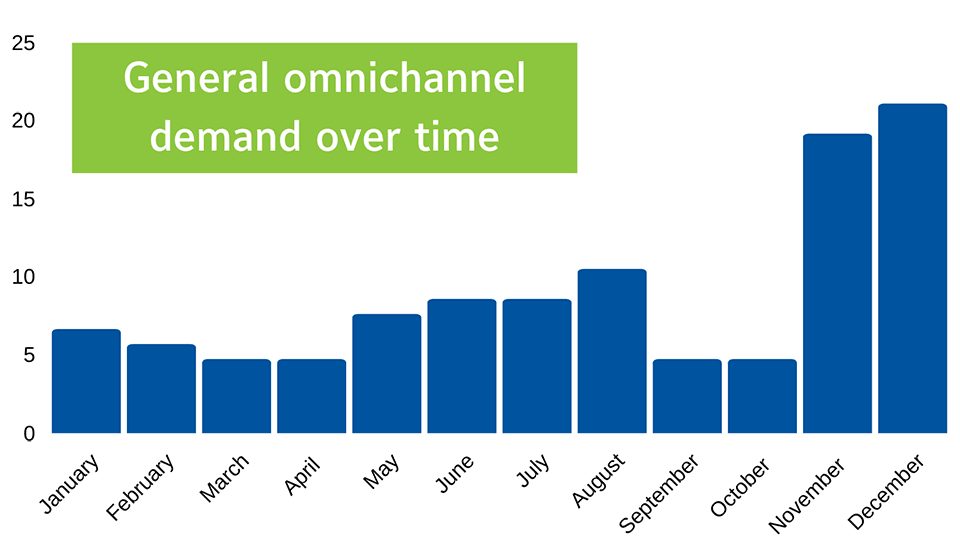Article
Holiday Omnichannel Can Feel Like Madness — but it Doesn't Have To

Inventory inaccuracy isn't just a hassle — it has real-world consequences for revenue and the customer experience. Here's how to overcome it before the holiday season arrives.
As omnichannel retailers prepare for another holiday season, inventory will likely be front of mind — as it should be. Long gone are the days when a store manager/owner only had to worry about stocking the floor with enough inventory for daily in-store shoppers. The rise of omnichannel means retailers need to be able to pivot quickly to accurately allocate inventory to meet demand that is coming from, well, everywhere. That's a lot of pressure.
Will the order cancellation rate due to lack of inventory ultimately plague them again this year? Will they again unnecessarily erode their margins in the process of satisfying the shopper — all because of store inventory inaccuracy?
But, come the holiday season, it's not just the high demand that's a challenge. Let's take a look at why inventory inaccuracy is especially detrimental during the holiday season, and what retailers can do to mitigate the risks and consequences.
It's true inventory inaccuracy is a common omnichannel challenge year-round, but the holiday season is most vulnerable to its woes.
The impact of inventory (in)accuracy
It's true inventory inaccuracy is a common omnichannel challenge year-round, as cited by McKinsey & Company, but the holiday season is most vulnerable to its woes. Indeed, with the right inventory strategy, retailers can enjoy a stellar omnichannel fill rate through other periods of high demand, like back to school or Easter. Back in summer 2018, for example, Target had their largest digital day in their history when they mirrored Amazon’s Prime Day, as reported by Retail Dive, with nearly 90% of this demand fulfilled by their stores.
So, why is it that the peak holiday season puts an extra special strain on inventory accuracy?
Because most retailers can only take a full physical inventory once a year, and in most cases, they perform these just after their holiday peak season or sometime in January. From that point forward, store inventory starts to erode by 2%-3% per month. If this pace holds, by the time a retailer reaches the next holiday season their item-level inventory accuracy has depleted to as low as 65%-70%. This leaves retailers stocking stores and filling orders from existing inventories that may be only 65% accurate. And that is why retailers’ ability to fill omnichannel orders gets more complicated, more expensive, and in some cases, unsuccessful, as they move into the peak holiday season.

Source: PRI/Platt Retail Institute
It is a “perfect storm” of the highest possible demand for store inventory when the retailers’ inventory accuracy is at its most inaccurate point. The chart below highlights a given retailer’s omnichannel demand plotted on the same inventory accuracy chart. In this case, 40% of the demand occurred in the last two months of the holiday season, when their inventory accuracy was below 70%.

Source: PRI/Platt Retail Institute
“When peak demand meets peak inventory accuracy, retailers risk lost revenue, productivity, and customers.”
Ted McCaffrey, National Accounts Sales, Inventory Intelligence & IOT at Sensormatic Solutions
The perfect storm: lost revenue, productivity — and shoppers
When peak demand meets peak inventory accuracy, retailers risk lost revenue, productivity, and shoppers. Store associates spend valuable time looking for items that aren't actually there (or perhaps items that are there but simply can't be found), the order ends up canceled, and the customer frustrated.
Time is money, as we all know, and so it's important to have a grasp on the dollar cost of this labor. Generally speaking, it's estimated that in-store cost-per-pick is 1.5-2 times more than warehouse or fulfillment center picking, according to McKinsey & Company. Further quantifying the cost of omnichannel picking, packing, and shipping can be tricky — especially considering most retailers do not have dedicated associates for these tasks. Some retailers assign 5-8 minutes of labor for every omnichannel item sold. For sake of illustration, let's say an associate earning $15.00 per hour spends six minutes of labor on each omnichannel item. That is $1.50/ omnichannel item! Now imagine that cost-per-pick for your expected holiday omnichannel sales volume, and you see the problem.
An even more substantial cost, however, comes in two major areas: split shipments or multi-line orders being split between two or more stores, and complete order cancellations.
Every time a split shipment happens, a retailer’s margins erode by whatever is their cost of shipping. In my experience, most retailers split between 8%-11% of their orders, with that rate topping out between 30% - 40% for various apparel retailers. Consider these rates of split shipments with the cost of shipping and the sales volume of the holiday season — the cut into revenue is staggering.
Order cancellations are a much different story. When a retailer can’t find what they thought they had available in their stores, or they can’t find it in time to ship it to their customer before their service level agreements (SLA) expired, it's time to cancel. According to my experience, retailers typically cancel between 3%-5% of their orders. Add this season's supply chain issues to the mix, and cancellations become more of a headache.
In addition to the loss of associate productivity due to searching for a missing item, order cancellations can incur a multitude of additional costs.
- The loss of the sale
- Possible markdown costs if this is a seasonal item that does not sell within the right timeframe
- Labor time of an administrator to manually cancel the order
- The loss of a valuable customer
“From factory to floor to fulfillment, retailers who use inventory solutions that harness the cutting-edge capabilities of RFID know where their merchandise is with confidence.”
Ted McCaffrey, National Accounts Sales, Inventory Intelligence & IOT at Sensormatic Solutions
How to stop the madness: RFID
Retailers may rely on their order management solution (OMS) to set up order broker rules to smooth out these above inefficiencies. However, if a retailer’s inventory accuracy was poor, that bad data will result in bad decisions.
Other retailers address this inventory accuracy problem by adjusting a “safety stock” — once an item's “safety stock” level falls below this amount, it is considered “out-of-stock” for digital transactions, despite the actual stock in a warehouse or store. While this approach protects against overpromising merchandise to an omnichannel shopper, it leaves money on the table.
For example, back in 2016 Macy's discovered they were withholding $1B of safety stock inventory from online purchases, according to Chain Store Age, since these items represented an on-hand quantity of one in each of their stores — all because they didn’t have enough confidence in the accuracy of their data.
Macy's was able to sell this inventory by utilizing RFID and its resulting 98% inventory accuracy to create a unique concept called “Pick to the Last Unit” which opened up this valuable inventory for omnichannel purchases.
Another global apparel retailer, lululemon athletica, similarly integrated RFID, resulting in an astounding 98% inventory accuracy, reported by RFID Journal. This high confidence in their inventory accuracy allowed them to deploy their omnichannel ship-from-store solution with great success, cited RIS News.
This is the power of RFID-enabled inventory solutions to consider. When a retailer adopts RFID technology, they gain the full potential of their inventory. From factory to floor to fulfillment, retailers who use inventory solutions that harness the cutting-edge capabilities of RFID know where their merchandise is with confidence. And this pays dividends in revenue, productivity, and shopper loyalty.
The bottom line: Omnichannel is here to stay, and the holidays are coming. This reality makes inventory accuracy paramount for both revenue and customer retention.
Watch our recorded LinkedIn Live, “Retailer Holiday Season Breakdown, Part 1” to hear more on how to think about your inventory strategy as you navigate through the peak season.
Watch our recorded LinkedIn Live, “Retailer Holiday Breakdown, Part 2: The Demise of Safety Stock – Holding back inventory in case you ‘may’ need it?”
About the Author

In his role in National Accounts Sales, Inventory Intelligence & IOT at Sensormatic Solutions, Ted McCaffrey brings a depth of knowledge after a seasoned career in sales within the retail industry. Ted joined Tyco in 2004 to sell the new IoT (Internet of Things) technology called RFID to the retail vertical. He left Tyco in 2013 for a division of eBay called VendorNet, where he sold omnichannel solutions. Ted returned to Tyco in 2015 to use his expertise and experience with omnichannel to showcase inventory accuracy and the benefits of RFID to retailers.
Explore Related Topics

